Pets are like family, and pet owners do everything in their power to protect their furry pals from harm. Unfortunately, accidents and emergencies may still happen, despite your best guardian efforts. Eye injuries and eye trauma can be especially upsetting for pet owners, who immediately empathize with their furry pal’s plight and worry about their emotional state and physical wellbeing.
The Envision More Veterinary Ophthalmology team is experienced in handling pet eye trauma and emergencies, but we understand these are far from routine for the average pet owner. Knowledge is power, so we’re discussing the most common problems associated with eye trauma in pets and explain what you should do if your pet needs emergency eye care.
What is eye trauma in pets?
Eye trauma is any injury to the eye or the structures surrounding the eye, including the soft tissues, muscles, and skull. The various traumas include:
- Major trauma — A vehicle collision, fall from a height, or animal bite
- Blunt trauma — A blow from a blunt object (e.g., a tennis ball)
- Penetrating trauma — A blow, laceration, or puncture from a sharp object (e.g., a cat claw, a stick)
Proptosis in pets
Proptosis is the dislodgement of the eyeball (i.e., globe) forward out of the eye socket (i.e., orbit) after a blow to the head or a high-pressure animal bite. If the muscles and nerves around the eye are damaged, swelling, spasms, bleeding, and pain quickly occur, preventing the eye from popping back into place. Once out of place, the eye surface becomes dry and ulcerated.
Around 25% of dogs who experience proptosis can recover vision if the eye is rapidly replaced surgically, but this depends on the amount of damage to the eye and nerves supplying the eye. Many pets will require eye removal instead of eye replacement after the initial trauma, or at some future point when vision loss becomes apparent or the proptosis recurs. Short-nosed breeds with large eyes and wide eyelid openings (i.e., brachycephalics) are most at risk. Surgery that narrows the eyelid openings may prevent the other eye from proptosing in predisposed pets.
Eyelid lacerations in pets
The eyelids are important for maintaining eye health—an irregular or damaged eyelid margin could eventually lead to corneal damage. Eyelid lacerations, which commonly result when pets roughhouse or fight, require surgical repair by a skilled veterinary surgeon or ophthalmologist to ensure proper function. Third eyelid damage may necessitate removal rather than repair.
Corneal injuries and perforation in pets
The cornea, which is the clear “window” covering the eye’s front portion, provides protection and nourishment to the interior structures while allowing entry of light and visual information, and can be scratched, ulcerated, completely ruptured, or lacerated from various traumatic events. Treatment for superficial or mid-depth corneal injuries is typically medical, but deeper or penetrating injuries may require surgical grafting and repair.
Objects that completely puncture through the cornea can damage structures inside the eye or cause a deep infection. Damage restricted to the eye’s front portion can often be managed with intensive medical care, and preserving vision is possible, but damage that extends to the eye’s back portion may cause irreversible vision loss.
Intraocular bleeding or inflammation in pets
Bleeding (i.e., hyphema) and inflammation (i.e., uveitis) inside the eye can result from a penetrating corneal injury or after blunt trauma. Bleeding in the eye front may temporarily obstruct vision, while bleeding in the back can cause permanent vision loss. Uncontrolled inflammation can lead to secondary glaucoma and subsequent blindness. Aggressive treatment with anti-inflammatory medications best reduces inflammation, prevents complications, and preserves vision.
Retinal detachments in pets

The retina lines the back of the eye and hosts cells that detect and process light, and when the retina does not function, vision is lost. Unfortunately, the retina is somewhat delicate and may detach after various eye traumas or as a complication after surgically attempting to repair a traumatized eye. Occasionally, the retina may re-attach with treatment, but this vision loss is often permanent.
A traumatic eye injury can be painful for pets and permanent eye damage or vision loss can result. Always seek immediate veterinary care through your primary veterinarian, a local emergency veterinary facility, or our Envision More Veterinary Ophthalmology team if your pet sustains head or eye trauma—whether the injury appears mild or severe. Your pet also should be completely evaluated for other injuries.
Vision loss can occur quickly after an injury, but rapid and aggressive treatment will improve the chances of a successful outcome. Contact our team if your pet has an eye emergency or with any other eye health concerns.







Leave A Comment